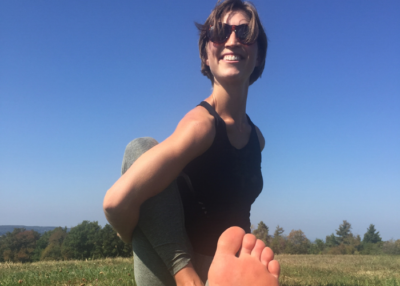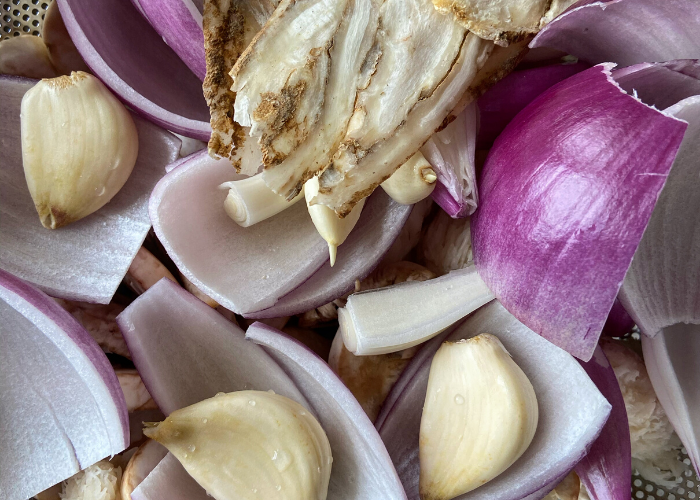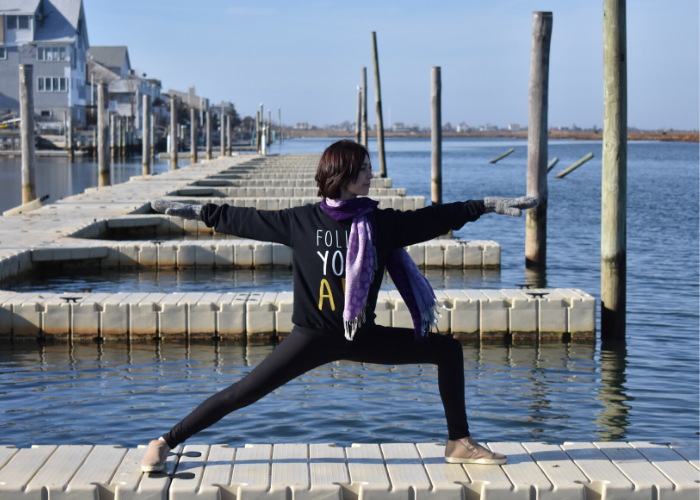The Kidneys & Marichyasana
The relationship between acupuncture point Kidney 1/yong quan & Marichyasana/ray of light pose
There is a point on the bottom of the foot called yong quan, or Kidney 1, which translates to gushing spring. It is the first point on the kidney channel and the lowest point on the body.

Its location is “on the sole of the foot, between the second and third metatarsal bones, approximately ⅓ of the distance between the base of the second toe and the the heel,” (Al-Khafiji, Baker, Deadman, 336).
Yong quans actions included resuscitation, clearing empty heat, calming the spirit, and tonifying yin. It’s use is indicated for conditions such as loss of consciousness, wind stroke, epilepsy, madness, paralysis, jaundice etc. Though we don’t often see these conditions in modern day clinical practice, the point is still very useful for more common situations.
Through its “powerful effect on reducing excess above by returning the unrooted back to its source,” Kidney 1 is an excellent point for settling the spirit. I use it often in my clinic as an acupressure point after inserting the rest of the patients needles during treatment. I place my thumb over Kidney 1 and sit at the patient’s feet. Often I will also place my second finger over Liver 3/great rushing while connecting to the sole
of the foot. I use most often it if a person is anxious and having trouble settling. I don’t often needle it directly unless I am treating foot pain.
Marichyasana is part of the seated sequence in the ashtanga primary series. This is the yin counterpart to the first part of the sequence which is yang, the standing sequence. The kidneys are a yin organ. In the yoga pose marichyasana, yong quan is activated in both feet during the pose. On the inside foot, it is planted down, the foot is grounded and there is a slight space between the point and the ground as the toes gently grip the grass. On the outside foot, yong quan is extended outward. The toes are flexed and the entire leg is engaged stretching through the hamstrings and calve muscles. Both feet are activated and involved. Engaging through Kidney 1 allows for the body to settle and “helps the body absorb the yin of the earth,” (earthing! ✌️) (Al-Khafiji, Baker, Deadman, 337).

The pose marichyasana is named after the great sage Marichi. Marichi is Sanskrit for “ray of light.” So marichyasana is referred to as either great sage pose or ray of light pose. Mariachi the great seat symbolizes great power, wisdom, and the cosmic force of creation. (http://www.rockclimbingyogi.com/blog/story-behind-the-pose-marichyasana)
The kidneys also embody these qualities! The kidneys are the root of qi and control the fire of the gate of life. (Flaws, 49). It is where we store the essence and the life force bestowed upon us at birth from our mother and father (our primordial yin and yang). This congenital qi is something that cannot be altered. However, we can sustain it by engaging in yang sheng, life nurturing activities.
Marichyasana “calms the brain, stretches the spine and shoulders, and stimulates the liver and kidneys (https://www.yogajournal.com/poses/pose-dedicated-to-the-sage-marichi-i) The kidneys govern the bone. Bones generate marrow, the brain is the sea of marrow. Liver and kidney are of the same source (Flaws, 48-54).

The kidneys are the viscous of water and fire; inside them are true yin and yang.
The kidneys belong to water and the heart to fire, and the kidneys and the heart. They mutually support each other, the kidney yin nourishing and listening heart yin and restraining heart fire, and heart yang descending to warm the kidneys. Harmony between the kidneys and heart is one of the prerequisites for a stable and peaceful spirit. When kidney yin is deficient and deficiency fire of heart blazes, or when the connection is broken and the kidneys and heart do not communicate, the spirit becomes agitated, leading to a wide variety of emotional disorders ranging from the mild (agitations, insomnia, poor memory, propensity to fear) to the severe (madness, rage, desire to kill). (Al-Khafiji, Baker, Deadman, 337).
Another name for yong quan is di chong/earth surge. In the yoga pose marichyasana, the planted foot is grounding towards the earth. In opposition the outside leg is extended out. The toes are dorsi flexed and yong quan is reaching outwards, while the chest and upper body is expansive and upright and the spine is long. The kidneys store the spirit of a persons will, or zhi. When we sit in seated poses during yoga, the kidneys are settled and a propensity towards fear has an opportunity to be calmed. With the kidneys grounding, the crown of the head can stand tall and towards the sky with a courageous spirit, and the heart is free from constraint.

The final variation of marichyasana involves forward folding over the extended leg. The kidneys govern stillness, and with stillness allows for the body to do its job to store. As the heart folds over the leg, there is space for yin activities like reflection, release and peacefulness. The low back stretches long creating space for movement and for the kidneys to perform optimally.
If you are feeling anxious of having racing thoughts you can help to settle and ground yourself by gently massaging the area on of yuan quan on the sole of your foot. It’s an especially good thing to do before bed if you have trouble falling asleep or wake often in the night.
You can also nourish your kidneys by engaging in grounding activities like meditation, yin yoga, acupuncture and journaling, and by eating foods such as eggs, walnuts, black sesame, miso, seaweed, bone broth, and meat cooked on the bone. We want to nourish our kidneys as much as possible so we can reserve our Jing essence! 🙂
Barring accidental death or infectious disease we are designed to last 100 years as long as former heaven essence is not squandered by excessive consumption, and as long as latter heaven or acquired essence in manufactured and stored to bolster and slow the use of former heaven essence (Flaws, 10).
*Disclaimer – This post is not intended to be a substitute for professional medical advice, diagnosis or treatment. Always seek the advice of your qualified health care provider with any questions you may have regarding a medical condition or treatment and/or before undertaking a new health care regimen. Please never disregard professional medical advice or delay in seeking it because of something you have read on this website. Do not attempt advanced yoga poses without the guidance of an experienced instructor.
Works Cited
Flaws, Bob. Statements of Fact in Chinese Medicine. Blue Poppy Press, 2004.
Flaws, Bob. The Tao of Healthy Eating. Blue Poppy Press, 1998.
Deadman, Peter, et al. A Manual of Acupuncture. Journal of Chinese Medicine Publications, 2016.
Editors, YJ. “Pose Dedicated to the Sage Marichi I.” Yoga Journal, Yoga Journal, 28 Aug. 2007, www.yogajournal.com/poses/pose-dedicated-to-the-sage-marichi-i.
Seibert, Ann. “Story Behind the Pose: Marichyasana and the Sage Marichi.” Rock Climbing Yogi, www.rockclimbingyogi.com/blog/story-behind-the-pose-marichyasana.
lokah samastah sukhino bhavantu




